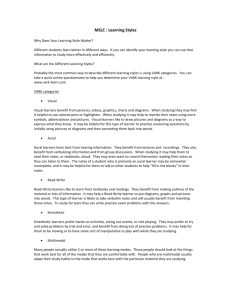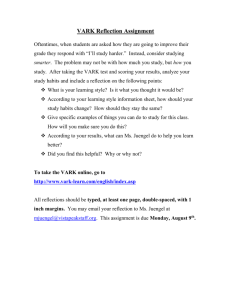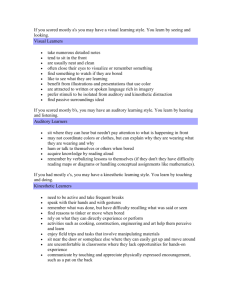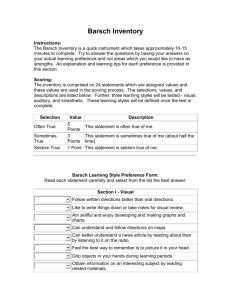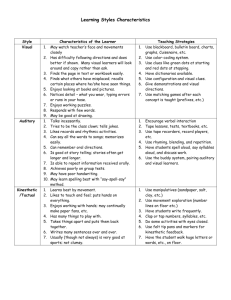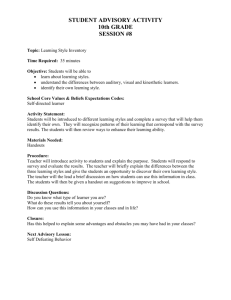Sensory perception and learning style. The implementation
advertisement
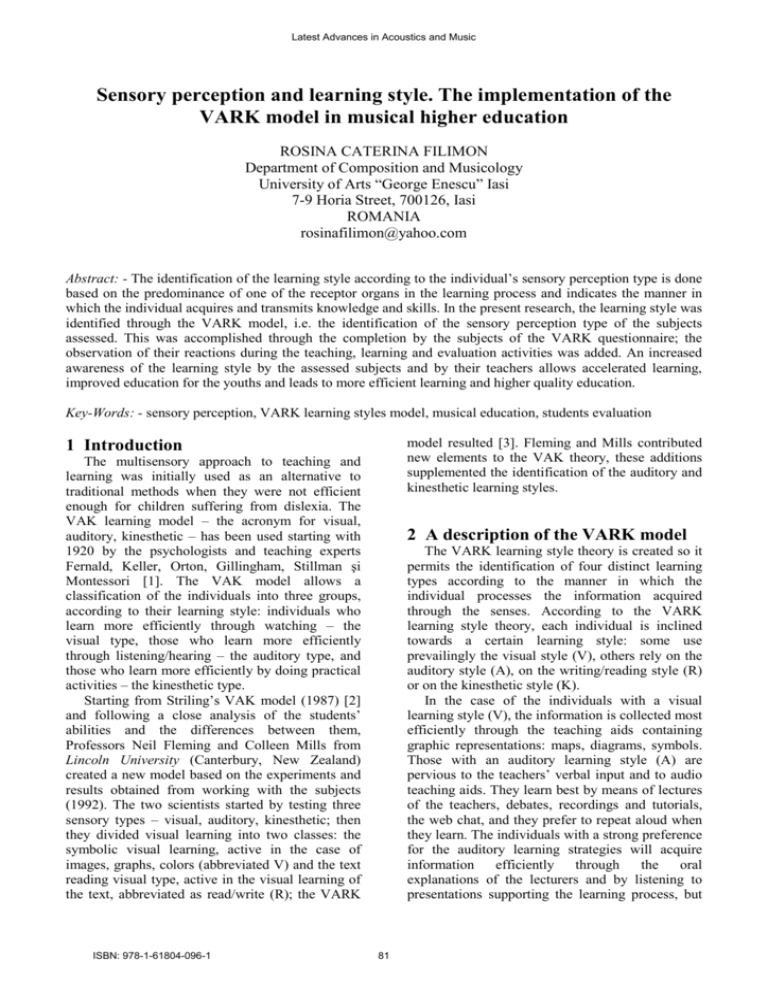
Latest Advances in Acoustics and Music Sensory perception and learning style. The implementation of the VARK model in musical higher education ROSINA CATERINA FILIMON Department of Composition and Musicology University of Arts “George Enescu” Iasi 7-9 Horia Street, 700126, Iasi ROMANIA rosinafilimon@yahoo.com Abstract: - The identification of the learning style according to the individual’s sensory perception type is done based on the predominance of one of the receptor organs in the learning process and indicates the manner in which the individual acquires and transmits knowledge and skills. In the present research, the learning style was identified through the VARK model, i.e. the identification of the sensory perception type of the subjects assessed. This was accomplished through the completion by the subjects of the VARK questionnaire; the observation of their reactions during the teaching, learning and evaluation activities was added. An increased awareness of the learning style by the assessed subjects and by their teachers allows accelerated learning, improved education for the youths and leads to more efficient learning and higher quality education. Key-Words: - sensory perception, VARK learning styles model, musical education, students evaluation model resulted [3]. Fleming and Mills contributed new elements to the VAK theory, these additions supplemented the identification of the auditory and kinesthetic learning styles. 1 Introduction The multisensory approach to teaching and learning was initially used as an alternative to traditional methods when they were not efficient enough for children suffering from dislexia. The VAK learning model – the acronym for visual, auditory, kinesthetic – has been used starting with 1920 by the psychologists and teaching experts Fernald, Keller, Orton, Gillingham, Stillman şi Montessori [1]. The VAK model allows a classification of the individuals into three groups, according to their learning style: individuals who learn more efficiently through watching – the visual type, those who learn more efficiently through listening/hearing – the auditory type, and those who learn more efficiently by doing practical activities – the kinesthetic type. Starting from Striling’s VAK model (1987) [2] and following a close analysis of the students’ abilities and the differences between them, Professors Neil Fleming and Colleen Mills from Lincoln University (Canterbury, New Zealand) created a new model based on the experiments and results obtained from working with the subjects (1992). The two scientists started by testing three sensory types – visual, auditory, kinesthetic; then they divided visual learning into two classes: the symbolic visual learning, active in the case of images, graphs, colors (abbreviated V) and the text reading visual type, active in the visual learning of the text, abbreviated as read/write (R); the VARK ISBN: 978-1-61804-096-1 2 A description of the VARK model The VARK learning style theory is created so it permits the identification of four distinct learning types according to the manner in which the individual processes the information acquired through the senses. According to the VARK learning style theory, each individual is inclined towards a certain learning style: some use prevailingly the visual style (V), others rely on the auditory style (A), on the writing/reading style (R) or on the kinesthetic style (K). In the case of the individuals with a visual learning style (V), the information is collected most efficiently through the teaching aids containing graphic representations: maps, diagrams, symbols. Those with an auditory learning style (A) are pervious to the teachers’ verbal input and to audio teaching aids. They learn best by means of lectures of the teachers, debates, recordings and tutorials, the web chat, and they prefer to repeat aloud when they learn. The individuals with a strong preference for the auditory learning strategies will acquire information efficiently through the oral explanations of the lecturers and by listening to presentations supporting the learning process, but 81 Latest Advances in Acoustics and Music tested along four years (four graduating generations); of this, 50 had attended a form of musical education in art vocational schools – Group A, while 50 had attended schools of a different type – Group B. The aim of the research was manifold: to identify the ratio of learning styles among students; to associate the learning style to the educational background; to increase the students’ awareness regarding their own learning style; to maximize the learning process. The research was started by finding the students’ opinion about their own learning style as they identified it during the learning process in the educational environment through individual study, the acquiring of information, knowledge and skills. This is useful in that increasing one’s awareness of their own learning style allows faster learning and improves education. The next step of the research was to obtain the answers to the VARK questionnaire (Version 7.0). The results were drawn from an analysis of the answers and an evaluation of the respondents’ behaviour during classes (piano practice), based on the manner in which students collected the information provided by the teacher and applied it. With respect to the students’ self evaluation of their learning style, it became apparent that the students’ opinion about their own learning style corresponds only in part with the reality, so that the learning strategies they consequently use are not in agreement with the results of the VARK questionnaire. Thus, only 32% of the students of Group A (students with previous musical education in specialised high schools) and 51% of the students of Group B (students without previous musical education in specialised high schools) (Table 1) evaluated their learning style correctly. Students who do not have a correct evaluation of their own perception style do not apply appropriate learning strategies, which thus are less efficient, while the learning process is not entirely successful. often they will not be able to take down exhaustive notes, as they are absorbed in listening to the information presented. It is therefore important that they should be provided with guidance to consult teaching material to complete their notes. In the read/write (R) learning style, the individual’s preferences are directed towards information presented through reading and writing in every form, respectively: textbooks, books, dictionaries, PowerPoint presentations, the Internet. The read/write (R) learning style represents one of the main modes of acquiring information by researchers and scientists. The kinesthetic learning type (K) implies using the experience acquired during and resulting from practical activities and it is a complex learning style: while it uses mainly the kinesthetic sensory organ, it also complements it through other sensory modes: visual, auditory, tactile, gustatory and olfactory [4]. The individuals who belong to this type are connected to reality through personal concrete experiences, case studies, practical activities and applications, demonstrations, simulations, multimedia presentations. There are cases when the learning styles are mixed; the result is a multimodal perception (MM). In other cases, the individual may move from one style to the other, depending on the environment in which the individual is educated and on age. The VARK questionnaire represents the main measuring instrument to identify the sensory type of the individual corresponding to their learning style. The questionnaire consists of 16 multiple choice questions, as it has been shown that this is the optimum number of questions a person should answer without losing interest and focus, so that the accuracy of the answers is the highest. Each question has four possible answers. 3 The implementation of the VARK model 32% Group A 51% Group B Table 1. A correct evaluation of one’s own learning style The unimodal style, prevailingly auditory in Group A is distributed as follows (Table 2): The purpose of the present research was to identify the students’ learning style by applying the VARK method on the students attending a musical higher education program, namely The University of Arts “George Enescu” Iasi, The Faculty of Composition, Musicology, Musical Pedagogy. One of the goals of this research was to analyse possible differences between the learning style of students coming from musical pre-higher education and the learning styles of students coming from education institutions of other types than musical one. A number of 100 students in their first year, were ISBN: 978-1-61804-096-1 Unimodal style percentage Visual (V) 7% Auditory (A) 22% Read/Write (R) 4% Kinesthetic (K) 10% Table 2. Group A – unimodal style 82 Latest Advances in Acoustics and Music which 4% students belong to the read/write, visual and kinesthetic style, while 2% belong to the trimodal style, with a mixture of read/write, visual and audio. None of the subjects in Group B has the tetramodal VARK learning style (Table 7, Table 8). In the case of Group B, the read/write style is predominant (Table 3): Unimodal style percentage Visual (V) 12% Auditory (A) 9% Read/Write (R) 47% Kinesthetic (K) 7% Table 3. Group B – the unimodal style Multimodal style percentage Bimodal 19% Trimodal 6% Tetramodal 0% Table 7. Group B – the multimodal style (MM) The multimodal style prevails in the case of Group A (as compared to Group B) (Table 4): Bimodal Trimodal R+V 11% R+V+K 4% R+K 8% R+V+A 2% Table 8. Group B – the bimodal style and trimodal style 57% Group A 25% Group B Table 4. The multimodal style In Group A there are 57% students with a multimodal learning style (MM). The 37% of the students with multi-modal learning style have been identified as having a bimodal learning style. In the sequel, 19% of these students have an auditory style mixed with the visual style, and the remaining 18% students have an auditory style and kinesthetic style, respectively. Finally, 17% of the students with multi-modal learning style have been identified as having a trimodal style, which was divided as: 14% students with an auditory style mixed with visual and kinesthetic styles and 3% combine auditory, visual and read/write combination styles, respectively. Of the total 50 subjects interviewed in Group A, three students were identified to have a tetramodal VARK learning style; they are among the best students in the faculty (Table 5, Table 6). In conclusion, in Group A 46% of the subjects have a unimodal style and 54% have a multimodal style (Table 9): 43% Unimodal style 57% Multimodal style Table 9. Group A – the unimodal style and multimodal style In Group B, 75% of the subjects have a unimodal style and 25% have a multimodal style (Table 10), respectively: 75% Unimodal style 25% Multimodal style Table 10. Group B – unimodal style and multimodal style Multimodal style Percentage Bimodal 37% Trimodal 17% Tetramodal 3% Table 5. Group A – the multimodal style It can be seen that in Group A the auditory style (A) is predominant; while in Group B the percentage of students with a kinesthetic style (K) and a multimodal style (MM) is higher (Table 11): Bimodal Trimodal A+V 19% A+V+K 14% A+K 18% A+V+ R 3% Table 6. Group A – the bimodal style and trimodal style V 7% Group B is mainly focused on the read/write style (R) and the percentage of students with the multimodal style (MM) is lower in comparison to Group B (Table 12): The percentage of students with multimodal learning style in Group B is 25%, distributed as follows: the bimodal style rises to 19%, and consists of 11% read/write and visual styles, and the rest of 8% are read/write and kinesthetic styles. The percentage of the trimodal style is 6%, of ISBN: 978-1-61804-096-1 A R K MM 22% 4% 10% 47% Table 11. Group A and learning styles V A R K MM 12% 9% 47% 7% 25% Table 12. Group B and learning styles 83 Latest Advances in Acoustics and Music speed of the learning process, maintenance and development of multiple intelligences, improving education quality. 4 Conclusion The results prove that the individuals who come from a background of non-musical education are used to traditional teaching methods, so the predominant learning style is the read/write style. In the case of subjects with an artistic education, the learning process stimulates both their auditory and visual organs and their manual dexterousness through the practical activities required, respectively study and interpretation, marking the cadence alongside with solmization, the reception of the auditory material and musical and harmonic dictation. In this way, artistic education develops the multisensory perception, which in turn develops several learning styles: the predominant in this case is the auditory style, followed by the visual and kinesthetic styles; to this, a high proportion of incidences of the multimodal style is added. The multisensory perception in the learning process of musicians involves the need for teaching strategies diversification of the teaching staff in the musical institutions (both, in pre-higher and higher education), which determines the efficiency and ISBN: 978-1-61804-096-1 References: [1] Adrian Mackay, Motivation, Ability and Confidence Building in People, Elsevier Butterworth-Heinemann Publisher, Burlington, MA, 2007, p. 204. [2] Neil Fleming, David Baume, Not Another Inventory, Rather a Catalyst for Reflection, To Improve the Academy, Lincoln University, Canterbury, New Zealand, Vol. 11, 1992, p. 138. [3] Constance C. Staley, Focus on College Success, Wadsworth Publishing, Boston, SUA, 2010, p. 54. [4] Neil Fleming, David Baume, Not Another Inventory, Rather a Catalyst for Reflection, To Improve the Academy, Lincoln University, Canterbury, New Zealand, Vol. 11, 1992, p. 140. 84



